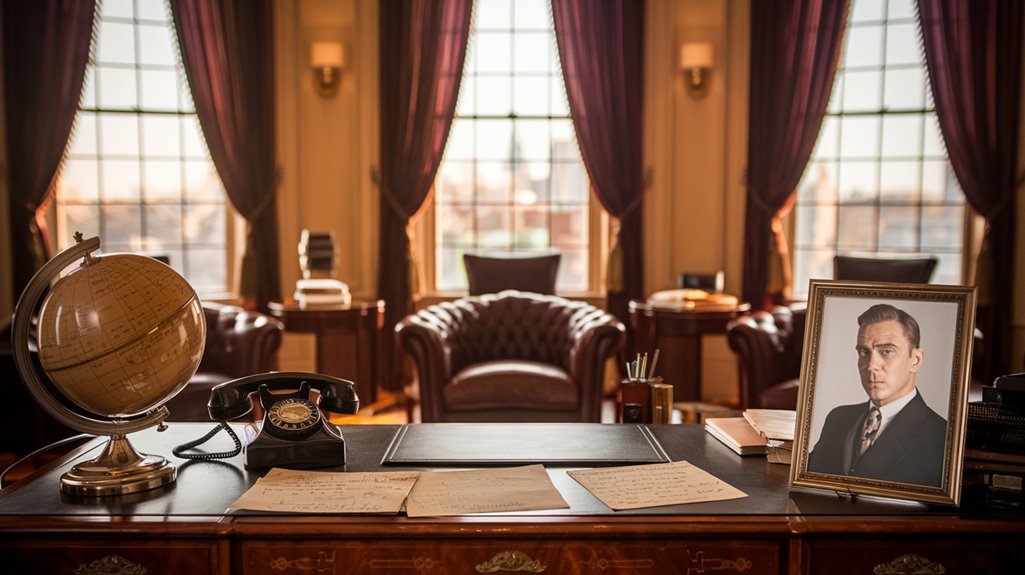The Real Bond Villain Feud: The Spy Drama Ian Fleming Drew From
You've probably assumed James Bond's villains emerged purely from Ian Fleming's imagination, but you'd be wrong. When you peel back the layers of Fleming's spy fiction, you'll find a web of real-world espionage that shaped these iconic antagonists. From his desk at Naval Intelligence during World War II, Fleming encountered actual spies and double agents whose actions would later inspire characters like Hugo Drax. The truth behind these villains proves far more fascinating than fiction.
The SMERSH Factor: Soviet Espionage Meets Fiction

While many Bond villains emerged from Ian Fleming's imagination, SMERSH represented a very real Soviet counterintelligence agency that he incorporated into his fiction.
You might be surprised to learn that this organization, whose name literally means "Death to Spies," wasn't just a dramatic plot device but a ruthless force in World War II and beyond.
SMERSH operations were far more chilling than their fictional counterparts, identifying 30,000 supposed German spies and arresting over half a million Soviet soldiers.
They employed torture, executions, and Soviet propaganda to maintain control and worked closely with Soviet spy rings that infiltrated Western governments.
Stalin's directive officially established SMERSH in April 1943 to combat espionage threats.
Even today, you can see SMERSH's legacy in Russia's occupied Ukrainian territories, where a revived version continues to suppress dissent through forced confessions and intimidation tactics.
Fleming didn't need to embellish much – the real organization was terrifying enough.
Operation Mincemeat's Shadow on Bond's World
Before Ian Fleming created James Bond, he helped orchestrate one of WWII's most audacious deception operations.
As a Naval Intelligence officer, he played a key role in Operation Mincemeat, where a corpse carrying false documents fooled German forces about Allied invasion plans. Winston Churchill personally endorsed the daring mission despite initial doubts from his advisors.
The deception techniques he mastered during the operation – creating convincing false identities, planting misleading documents, and manipulating enemy intelligence – became recurring elements in 007's adventures.
Fleming's initial contribution came through the Trout Memo, which compared deception tactics to fly fishing and helped lay the groundwork for the operation's concept.
Just as Operation Mincemeat relied on sustaining a believable fiction, Bond's success often hinges on maintaining elaborate covers and deceiving his adversaries.
Fleming's firsthand experience with this historic military deception shaped how he wrote about espionage, lending authenticity to his fictional spy world.
You can see Operation Mincemeat's legacy throughout Fleming's Bond novels.
Naval Intelligence Days: Fleming's Real-Life Spy Games
Operation Mincemeat marked just one highlight in Ian Fleming's remarkable career as a naval intelligence officer.
Starting in 1939 as Admiral Godfrey's assistant, he'd quickly rise to commander and master various espionage tactics from Room 39, leaving an intelligence legacy that would later shape his James Bond novels.
You'll find his most daring achievements in founding the 30 Assault Unit, which operated behind enemy lines with missions that included:
- Collecting intelligence on German nuclear programs
- Retrieving vital frontline documents
- Conducting operations across Europe and North Africa
He'd orchestrate complex operations from monitoring the Suez Canal to preventing German control of the Danube River.
His work with German scientist defections and strategic deception operations proved instrumental in Allied success, foreshadowing the intricate plots he'd later weave into fiction.
After never joining MI-6, he focused on crafting stories from his naval intelligence experiences.
After the war, he established his famous Goldeneye home in Jamaica, where he would later create his legendary spy novels.
The Erich König Connection: Birth of Hugo Drax
Among Ian Fleming's most compelling villain inspirations, German spy Erich König stands out as the real-life model for Hugo Drax in "Moonraker." König's attempted assassination of Winston Churchill in Cairo and his extensive Middle Eastern espionage activities caught Fleming's attention, providing the framework for Drax's character. Fleming's experience as Naval Intelligence Division officer added authenticity to the espionage elements.
König's impact on Fleming's writing went beyond surface-level inspiration. His wartime operations, deeply embedded in German military intelligence, shaped Drax's evolution from concept to fully realized antagonist. During the 1960s spy craze, Fleming's villain creation would influence countless other spy thriller antagonists.
You'll find König's influence throughout the novel, as Fleming masterfully wove real-world espionage elements into his fictional narrative. The character of Drax emerged as a powerful synthesis of König's actual exploits and Fleming's imagination, reflecting both the author's fascination with WWII German spycraft and the Cold War tensions of his era.
Room 39's Secret Files and Fleming's Imagination

When Ian Fleming crafted his Bond villains, he couldn't have imagined that North Korea's Room 39 would emerge as a real-world parallel to SPECTRE's criminal empire.
Like Fleming's fictional organizations, Room 39 orchestrates a vast network of illegal activities that would make any Bond villain proud.
Drawing from Fleming's influence on spy fiction, you'll notice striking similarities between Room 39's operations and SPECTRE's criminal enterprises:
- Counterfeiting currency and international fraud schemes
- Global arms trafficking violating UN resolutions
- Drug production and distribution networks
Fleming's naval intelligence background helped him create believable criminal enterprises in his novels, but Room 39's real-world operations surpass even his creative imagination. The organization's sophisticated methods include operating through 120 front companies to conceal their illicit activities. His time observing operations at Casino Estoril provided rich material for his fiction writing.
 two thousand words each day helped Fleming craft these complex villains with meticulous detail.
two thousand words each day helped Fleming craft these complex villains with meticulous detail.
These weren't just fictional adversaries – they represented Fleming's real-world animosities and observations from his time in Room 39.
The ruthless Le Chiffre emerged from Fleming's encounters with occultist Aleister Crowley, whose dark reputation and intelligence connections provided inspiration for the casino-dwelling villain.










